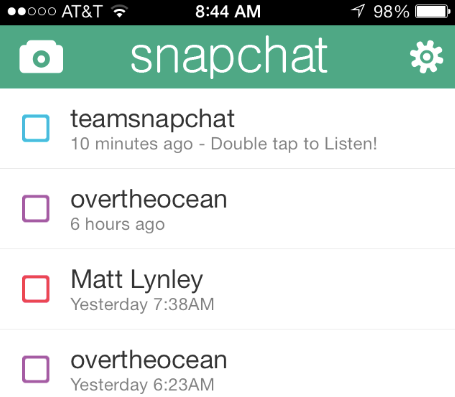Snapchat founder and CEO Evan Spiegel has kept quiet about how Stories, the app’s new 24-hour timeline play, might turn into a monetization route.
Forget the fact that Snapchat has released some of its first-ever commercials, and that those commercials were in collaboration with local LA bands. Don’t mind the fact that Snapchat has sent users these commercials with a direct link to the music of those bands on the iTunes store. It’s not a big step towards monetization. It’s “just a little experiment,” says Spiegel.
This morning, after unveiling Stories, Team Snapchat (Snapchat’s version of @Twitter on Twitter) has just sent out a message with one of the music videos inside, from Smallpools. At the end of the commercial, the user returns to the inbox, but instead of seeing a line of text under the snap that says “opened” it instead says “Double tap to listen.”
Users who double tap the message will instantly be sent to the Smallpools iTunes page.
If that’s not a step toward monetization, I don’t know what is.
“If anything, it’s a little experiment,” Spiegel told TechCrunch. “We wanted to work with LA bands, celebrate Los Angeles, and we thought working with them was a fun way to educate people about what stories are. Plus, it’s a good way for users to hear their music.”
It certainly is a good way to get Snapchat’s entire user base a direct link to purchase music they’ve just heard, sent directly to them from Snapchat itself.
In a conversation with The Verge, Spiegel reportedly smiled at the idea of music artists having the ability to share their days with users, as you have the option to share Stories with just friends or everyone. Furthermore, Snapchat users have the option to choose what goes into their Story and what remains a private, instantly disappearing message.
With the double click to listen feature, artists would have the opportunity to be personal with their fans and then leverage that personal connection into a sale almost instantly.
It’s still unclear whether or not Snapchat itself will be administering the click-to-buy functionality (through Team Snapchat), or if brands and artists can pay for the ability to add a “double click to listen” link under their own messages. For now, it seems that Snapchat is testing out the feature through the Team Snapchat username.
There are two sides to this, though. Team Snapchat hits the entire user base of Snapchat, which currently sends 350 million snaps per day, whereas individual artists must be added manually. Users who specifically follow artists may be a more valuable consumer of that Snap Story, and thus more likely to make a purchase at the end. With Team Snapchat versus individual artists, it’s quantity over quality.
When asked about the potential for brands to get their hands on the “double click to listen” feature, Spiegel said that Snapchat “has not thought that far down the road yet.”
Where Stories are concerned, Spiegel explained that the service is meant to be a representation of your actual life, rather than your digital life alone. That’s why everything is chronological, something he expressed as important back at Disrupt SF during an on-stage interview, and that’s why videos and photos are combined. “That kind of excitement and movement that you feel is something we hadn’t seen before in broadcast social media,” said Speigel.
The CEO said that soon, users will have custom control over who can see their stories, rather than offering just the two options of friends and everyone. He also noted that users can always see who is viewing their story, the same way Snapchat shows you when someone has opened your snap.
The idea here comes back to digital dualism, or the idea that our digital lives are separate from our real-world lives, something Spiegel loathes.
“We noticed that, even though one person is paying attention to another person’s social feed, they’ll pretend that they haven’t been paying attention in real life,” said Spiegel. “We wanted to make that real life interaction less awkward and more transparent.”
It’s also worth noting that Snapchat’s web profiles, showing a user’s best friends list (www.snapchat.com/jordanrcrook) have migrated to now show 404 errors. Speigel says that the company just wanted to move the best friends’ list into the app. The question, then, is why remove the web profiles, if there’s nothing to change about them? It doesn’t harm the native app experience to have web counterparts for that information, right?
Spiegel denies any changes to the profile pages, but the idea of 24-hour expiring timelines as the backbone profile pages of a web version of Snapchat sure does make sense.
If you want to learn more about Snapchat’s re-invention of the timeline with Stories, check out earlier coverage here.



